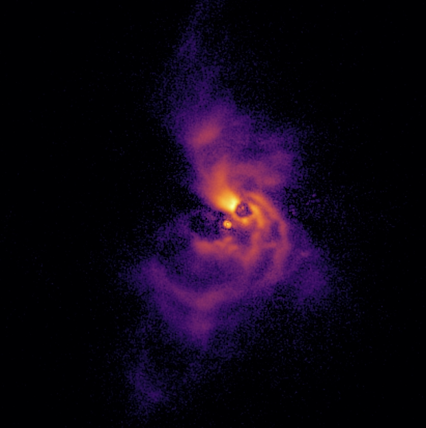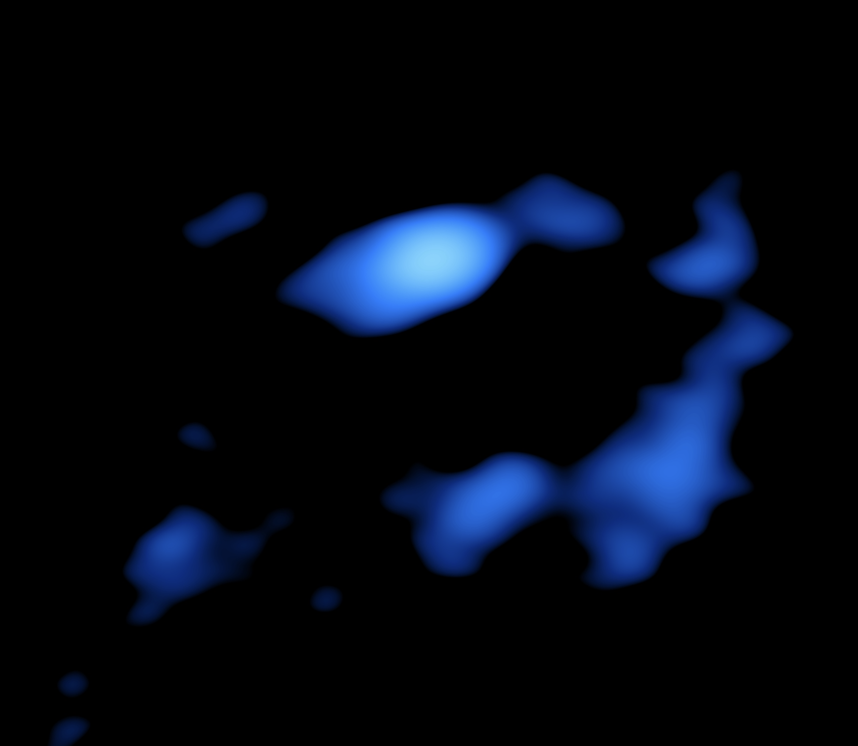First Observation of Gravitational Instability at Planetary Scales
The research by Weber et al. 2023b is published in the Astrophycal Journal Letters (ApJL). You can find the press release by the European Southern Observatory here.
Giant planets are thought to be formed in two different ways: either by gathering material around a solid core or through a process called gravitational instability (GI), which involves the fragmentation of circumstellar material . However, recent research suggested that gravitational instability is not as likely as previously thought. This is mainly because no convincing evidence for fragmenting disks has been found thus far at planet-forming scales. Nonetheless, GI is expected to be an extremely fast process in an astronomical context and the lack of evidence could just reflect the very low probability of observing the exact time of the disk fragmentation in any given system.
V960 Mon is a young star that is currently going through an outburst. In 2014 it suddenly became twenty times brighter than before, an event that might be related to the onset of GI. In our study, we used the instrument SPHERE/IRDIS of ESO/VLT to take scattered light images of this auspicious object V960 Mon. The image shows a complex surrounding of the star with several prominent spiral arms, a key signature in GI theory. This discovery led us to go back and analyze archival data of V960 Mon taken by ALMA at millimetre wavelengths. In these data, we found several clumps of dust emitting radiation, similarly arranged in a spiral arm. We think that these clumps formed when the spiral arm collapsed due to its own gravity, as predicted by GI models. By estimating the mass of the solid material in these clumps, which is several times the mass of the Earth, we believe this is the first observational evidence of the GI happening at masses comparable to planetary scales. This observation will spark a new discussion on planet formation by GI. The detection of millimeter flux demands that the disk material is currently still in the form of dusty clumps - but can these clumps eventually collapse to form giant planets in the future? Additional, more detailed observations should provide the answer.

A group composed of several YEMS members observed for the first time clear signs of Gravitational Instability on planetary scales. These "signs" are dust clumps around a young star that align along a spiral arm - a long sought feature as it is predicted by theory through numerical simulations. The existence of these clumps is of quite some significance. "These dusty clumps could potentially evolve into the cores of giant planets", says Sebastián Pérez, YEMS director and part of the investigation, "and since they are quite far from their star, those cores could get expelled as rogue planets, some of the many wandering freely in our Galaxy. Or perhaps they'll start falling in and be consumed by the star, helping it grow. Or maybe they'll break apart and contribute material back to the cosmic cloud, where more stars and planets can form in the future. We think this discovery in V960 Mon can guide our future searches of gravitational instability signatures using the new instruments at ESO and through dedicated ALMA observations."
The discovery was made possible by the usage of data of the Very Large Telescope of the European Southern Observatory (ESO) in Chile and the Atacama Large Millimeter/Submillimeter Array (ALMA). “The VLT/SPHERE instrument proves to be an exceptional tool capable of capturing and detecting scattered light emissions emanating from young disks", says Alice Zurlo, co-author and YEMS co-director, "It operates by capturing the reflected light from the dust present in the disk, which is then detected through the instrument's capabilities. This enables the revealing of remarkably faint disks encircling youthful stars. In this particular study, SPHERE provided an awe-inspiring image of the disk encompassing V960 Mon, exhibiting a series of breathtaking spiral arms extending over vast distances of hundreds of astronomical units."
The study reveals the complementing power of comparing images of different telescopes such as between VLT and ALMA. The ALMA image is shown here on the right hand side. "A fascinating revelation emerged when comparing the features of the disk with the ALMA millimeter image. It became apparent that the spiral arms within the disk were undergoing fragmentation, resulting in the formation of clumps with masses akin to those of planets."
YEMS' dedication to study young exoplanets might therefore departure at the very early stages of planet formation: before the planet itself exists. The environment and formation process will define the masses and composition of the planetary products. Would formation by gravitational instability be consistent with the exoplanets that we know? Can moons form around giant planets if they form via the gravitational instability?

The work is led by YEMS scientists including P. Weber, S. Pérez, A. Zurlo, J.Miley, L. Cieza, A. Hales and M. Cárcamo.
Image credits: ESO/ALMA (ESO/NAOJ/NRAO)/Weber et al. (Title background) and Weber et al. (integrated images)